The Simplified Akers–Agalloco Method for Aseptic Processing Risk Analysis
This article summarizes changes to the Akers–Agalloco aseptic processing risk analysis model (first presented in Pharmaceutical Technology's November 2005 issue) as well as some of the underlying thinking behind the revision. The simplified model makes the method easier to use because of its greater flexibility of environmental control practice. It maintains the emphasis on human activity as the primary consideration in risk management for aseptic processing.
When we first developed our risk analysis model, we shared it with a limited number of our peers. They were helpful in its development, and we incorporated nearly all their suggestions as we progressed toward completion. While we awaited its publication and after that as well, we discussed the model with many other individuals, and it became evident that it needed some modifications. The present article summarizes the changes made to the analysis model, the underlying thinking behind the revision, and to a lesser extent, the original effort. Before proceeding further, readers should review the earlier publication if they are not already familiar with it (1).

We received considerable comments about the inclusion of the background environment as a separate factor in the analysis. As we endeavored to explain our rationale for its inclusion, we found our support for its inclusion eroding. If the true emphasis was to be on the aseptic process, and even more narrowly on the human interventions performed, the effect of these background issues had to be minimal. Moreover, we included at the end of the analysis a further consideration of the primary processing technology used, and so in effect, we were addressing the same concern in two separate places. Thus in this article, we removed consideration of the background environment as a separate section and restricted consideration of the facility choice to the immediate proximity of the filling operation.
Because aseptic compounding and lyophilization might not use the same environmental control practices as the filling operation, the overall environmental factor was repositioned. Instead of applying it at the end of the analysis, the environmental factor is included separately for compounding, filling (including setup), and lyophilization.

Using the AkersâAgalloco model
We also altered the risk determination associated with thermocouple placement in lyophilizers. For consistency with the intervention risk associated with filling, we changed the multiplier for this practice to "per thermocouple."
These changes enabled us to eliminate what was termed the "aseptic processing factor" from the model. We added this factor to the model as we neared completion because without it, the largely human-supported activities were weighted too lightly. Call it a "fudge factor" if you will, but it was merely a means to ensure that the contributions from the various parts of the model were evaluated. By eliminating the background environmental section in its entirety and allowing for differing technologies in compounding and filling, the "aseptic processing factor" is eliminated in this simplified analysis method.
Some perspective on the effectiveness of high-efficiency particulate air (HEPA) filters
The initial version of this article contended that the majority of microbial contamination in aseptic processing was derived from personnel. Several references were included to support that position (2, 3). As we revised the method, we reflected on the industry's growing tendency to attribute microbial contamination to microorganisms that have presumably penetrated HEPA filters, thereby resulting in detectable levels in the environment (4). We found no scientific evidence that such penetration occurs in integral HEPA filters. Extensive data are available that support HEPA-filter retention at not less than 99.97% of particles larger than 0.3 μm. With that type of retention capability, the penetration of microorganisms is nearly impossible. Suggestions that it has occurred are suspicious in the absence of confirming data supporting that contention. The detection of microorganisms downstream of a HEPA filter is most likely the result of human activity in the preparation, placement, and recovery of microbial samples from the tested environment. The activities associated with environmental monitoring are carried out by aseptically garbed personnel, and there is no reason to believe that these individuals are capable of "perfect interventions" any more than a production operator would be. To suggest that integral HEPA filters contribute meaningfully to the microbial presence in aseptic processing ignores available data about human contributions and grossly overestimates the potential for filter penetration.
Numerous published studies indicate that for air moving at the flow rates and pressures typically used in cleanrooms and isolators, HEPA filters are as efficient at removing particulates (viable and nonviable) as a membrane cartridge filter. In many modern HVAC systems, 80% of the air is recirculated—that percentage is substantially higher in isolators—and thus is refiltered constantly by the HEPA filters. The remaining 20% or makeup air supplied to the system enters through at least one and often two additional prefilters. These are typically a 95% ASHRAE and a 99.97% HEPA filter that serves to reduce the microbial load even before it reaches the HEPA filter in the cleanroom or isolator.
When sampling a cleanroom in the unmanned condition, the microbial count is essentially zero. This result has been observed consistently in all modern aseptic, manned cleanrooms and is virtually always the case with isolation technology. For the sake of argument, consider a filling suite with full HEPA coverage and assume that each HEPA filter in that cleanroom passed 1 cfu/h testing. If there are 30 HEPA terminal filters in the ceiling, then the microbial ingress would be 30 cfu/h, which is a ridiculously high estimate. Even if every filter had leaks, it is very unlikely that the approximated figure is accurate.
Now, place two operators gowned in aseptic attire at work in that same fill room. They each will release 8000–15,000 cfu/h, depending upon their exertion level. Thus, comparing a worst case for microbial filter passage with a best case for human release, the fraction of contamination emanating from the HEPA filters is 30 versus 16,000 cfu from the operators. Based upon an assumed penetration of a single filter and average microbial discharge from the operators, a more realistic estimate is 1 versus 32,000 cfu.
For this reason, we have not considered any contribution of microbial contamination from HEPA filters. We emphatically believe that this should be completely ignored in aseptic processing risk analysis. Mentioning its potential even in passing belies its insignificance and dramatically overstates its criticality.
Environmental monitoring and risk assessment
A hidden influence in the initial article was our belief that environmental monitoring in aseptic processing areas, especially those operating at ISO 5, cannot be considered a quantitative activity. Over the past 20 years, the industry has been subjected to increasing restrictive environmental limits in these extremely capable environments. Unfortunately, the methods for microbial recovery and detection have not kept pace with the increasingly restrictive performance expectations. It is impossible to determine what level of microorganism is actually present in these cleanest environments with any degree of certainty.
For this reason, the present risk analysis method does not include any factors that cannot be determined with certainty. Most other aseptic risk analysis methods use assumptions or measurements of microbial content in an aseptic environment as a major factor. Nonetheless, the basic belief that present technology does not allow us to measure microbial levels accurately in an aseptic environment is fundamental to the Akers–Agalloco risk analysis method and differentiates it from other approaches (5).
The simplified model
The changes noted previously in this article have not altered the basic premises behind the model. The goal for this revision is clarity, consistency, and greater utility. Occurrence in the model includes the quantity and criticality of interventions as well as other process risk elements indirectly related to the core activity of aseptic filling. The following risks are included:
- Aseptic compounding. The contribution from aseptic compounding is calculated and adjusted for the environmental control system used separately from other activities.
- Aseptic setup. The contributions from aseptic setup and filling in these areas are individually calculated, summed, and then adjusted using a common factor for the environmental control.
- Aseptic filling (calculated differently for manual and machine processes). The contributions from aseptic setup and filling these areas are individually calculated, summed, and then adjusted using a common factor for the environmental control.
- Lyophilization (included where present). The contribution from lyophilization is calculated and adjusted for the environmental control system used separately from the other activities.
The risk for the overall process is the summation of the contributions from relevant process factors arbitrarily weighted by the authors to consider the differing impact of different practices. The determination of individual factors varies and includes simple multiplications reflecting the combined effect of variables within an individual process step. Addition is the primary means of calculation for the following reasons:
- It substantially simplifies the calculations (at least once the individual contributions have been determined).
- It is consistent in the sense that adding an activity (e.g., lyophilization) to a process adds risk to an existing process (e.g., solution filling). This calculation allows the elements of a larger activity to be addressed individually and directly and optimized from a risk perspective more easily.
Consistent with other risk assessment models, a lower score suggests a reduced potential for contamination. The risk contributions for the various process elements that comprise the overall aseptic process are described later in this article and are quantified in Tables I–IV.
The environmental technology used for aseptic processing plays a major role in risk assessment. This risk is applied separately to compounding and filling or lyophilization to allow for various environmental control methodologies in each area.
Aseptic compounding contribution
Processes that require substantial amounts of aseptic processing during formulation have an increased risk associated with activities that must be factored separately from the aseptic filling process. Factors in this area are the numbers of personnel interacting with the sterile materials, the duration of only the aseptic portions of the compounding process including setup and execution (exclusive of hold times in which the sterile material are secured and there is no supportive personnel activity in the environment), and the technology used for the process. Because these processes generally entail frequent human intervention to accomplish the process steps, interventions are not considered separately. If there are no poststerilization aseptic connections or opening of closed systems, then the risk contribution from this portion of the overall aseptic process can be zero (6). This contribution may be present for even the simplest products for which the only postfiltration activity with sterile materials is associated with sampling or verification of filter integrity. The environmental factor for aseptic compounding is based upon the environment in which any aseptic manipulations occur.

Table I: Risk factors in aseptic processing for compounding.
The process time (including any required aseptic setup for compounding) is multiplied by a novelty factor (which is based upon the experience of personnel, the newness of the equipment, and the novelty of the process) and the environmental technology factor to determine the aseptic compounding contribution to process risk (see Table I for risk factors relating to compounding). The novelty factor is calculated in an identical matter in all process steps: compounding, filling, and lyophilization.
aseptic compounding risk contribution = process time × novelty factor × environmental technology factor
Aseptic setup contribution
The assembly and setup of filling equipment requires direct human manipulation of sterilized equipment and tools within the critical environment. In some firms, only the most experienced personnel whose proficiency in the required task has been confirmed by a successful media fill are allowed to perform this task. The hands-on nature of this activity often requires separate evaluation from that of the fill process itself.
The duration of the setup—which indirectly assesses the sophistication and complexity of the filling equipment and the uniformity of the components must be factored in. Because the setup is almost entirely performed by human operators, related processes interventions are not considered separately. Typically included in the setup are product connection and introduction, initial weight, closure systems checks, and any other relevant activity including environmental monitoring during this assembly and setup process. The expected additional setup concerns for suspensions, creams, ointments, and powders are factored into the setup duration time as are other elements such as stopper and vial uniformity, inert gassing system installation, as well as the more demanding requirements for double-chamber filling and other more complex package designs. Product formulation factors are incorporated into contributions from the aseptic execution as well. The location of sterilizing-grade filters in the product delivery system affects the risk of contamination entering a filled container.

Table II: Risk factors in aseptic processing for setup.
The aseptic setup risk is the result of multiplication of the process setup time, a complexity factor, a product delivery factor, and a novelty factor to determine the compounding contribution to process risk (see Table II for risk factors relating to setup).
aseptic setup risk contribution = setup time × complexity factor × product delivery factor × novelty factor
Aseptic filling contribution
The aseptic filling risk can be determined using an approach designed strictly for manual fills and a more general method for machine fills in which personnel play only a supportive role.
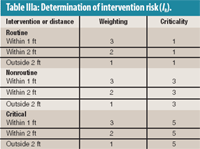
Table IIIa: Determination of intervention risk (IR).
Manual fills. The intervention risk is simply the number of times the individual parts of the package (e.g., vial, stopper) are handled to prepare one filled container. The result is incorporated with the other relevant factors for aseptic filling found in Table IIIb to define the overall risk for manual aseptic filling.
touches per unit = intervention risk (I R ) for manual filling
Manual filling must be considered the riskiest of all aseptic processes because the minimum number of required interventions (I R ) to fill and seal a container is greater than one.
Machine fills. Interventions during machine filling are substantially lower in number and thus have a reduced impact that is relative to manual fills. Critical interventions (e.g., the replacement of fill pumps or other critical dosing equipment) and any aseptic connections made or remade after the initial setup are scored as 5. All other interventions within 1 ft of the exposed product contact parts or components parts are scored as 3 on every occurrence. Interventions within 2 ft are scored as 2. Interventions outside 2 ft are scored as 1. Routine interventions that are an inherent part of every process are weighted at 1, and nonroutine (corrective) interventions are weighted as 3 (see Table IIIa).

Table IIIb: Risk factors in aseptic processing for filling.
Number of interventions. Calculate or visually confirm all interventions (routine and nonroutine) required during the process for a period of not less than one hour. Multiply each intervention by the appropriate proximity and type score. Determine the weighted number of interventions per hour by summing these values. Be sure to include all environmental monitoring-related interventions, which are often the most invasive because of their proximity to the critical environment.
Example:
- 4 routine interventions within 1 ft: 4 × 1 × 3 = 12
- 2 routine interventions within 2 ft: 2 × 1 × 2 = 4
- 1 nonroutine intervention within 3 ft: 1 × 3 × 1 = 3
- 2 nonroutine interventions within 1 ft: 2 × 3 × 3 = 18
- 1 critical intervention: 1 × 5 × 3 = 15
- Weighted interventions/h: 12 + 4 + 3 + 18 + 15 = 52
The score should be based upon the maximum number of interventions observed or allowed. The ideal number of required interventions is always zero.
The weighted number of interventions (normalized for criticality and proximity) per hour should be determined first. A longer evaluation period provides a more accurate assessment, as does averaging the number of observed interventions over the entire or even multiple batches. In determining intervention risk in this manner, the role of container–closure consistency in determining handling requirements is intrinsically included.
Intervention risk determination. The actual number of units is the amount produced during a 1-hour period and is not the theoretical line speed per minute multiplied by 60. The determination of this value over a longer period is preferred for improved accuracy. Do not include downtime periods when filling is stopped intentionally for activities such as lunch, breaks, or shift changes. Include in the calculation times when the fill is interrupted by interventions of any type. Divide these values by each other to determine the interventions per container. Again, a lower number is desirable. The value is the I R . Reductions in the number of interventions performed of whatever type should be the goal at all times. Interventions always increase the risk of contamination ingress to the product. Thus, any equipment design, corrective measure, component improvement, or other action that reduces the number of interventions required should be pursued regardless of any other considerations.
Adjusted product filling risk
Estimate the total risk from filling (for either manual or machine fills) by incorporating the remaining variables associated with the filling process: container size, complexity, container introduction method, closure-handling technology factor, and process duration.
The I R is multiplied by the fill duration in minutes, the container design factor, the container feed factor, and a closure feed factor. The longer the process duration, the larger the potential that at least one unit will be contaminated because of the increased number of interventions. Multiplying the valve of I R by the length of the process emphasizes the effect of filling speed, and includes consideration of fatigue as a factor in inducing contamination.
Further multiplication by the product and technology factors adjusts for the varying levels of contamination potential associated with various aseptic technologies and product formulation types. Thus, the risk contribution for filling could be determined by the following equation (see Tables IIIa–b for risk factors related to aseptic filling):
(normalized interventions/h) ÷ (containers/h) = interventions/container or I R .
I R × fill duration × container design factor × container feed factor × closure feed factor × novelty factor × product factor = contribution to risk from aseptic filling
Aseptic processing risk
The individual contributions from aseptic setup and aseptic filling are summed and multiplied by the environment control factor (see Table IIIc) associated with the prevalent technology used for filling.
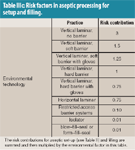
Table IIIc: Risk factors in aseptic processing for setup and filling.
Lyophilization risk (where present)
The lyophilization risk is associated with the time that filled components are exposed to the environment between first exposure and closure, as well as the handling practices, lyophilizer sanitization, sterilization practices, and the environmental technology factor. Loading time in minutes is reduced by a factor of 10 to avoid overweighting the lyophilization process risk contribution. Lyophilizer sanitization is not considered a current good manufacturing practice; some laboratory-scale lyophilizers cannot be sterilized (see Table IV for risk factors related to lyophilization).

Table IV: Risk factors in aseptic processing for lyophilization.
lyophilization risk contribution = loading time/10 × lyophilizer sterilization factor × load factor × transfer factor × tray factor × Thermocouple (Tc) factor × environmental technology factor
Overall aseptic processing risk
The simplified model merely sums the contributions from aseptic compounding, aseptic setup and filling, and lyophilization, with each adjusted to the prevalent environmental control design used. A lower number indicates a lower contamination risk in the finished materials. It is important to recognize that although summing the risk contributions from the various process elements allows for an overall assessment, consideration of each area independently is also necessary.
Consider the following example: The preparation of a sterile suspension could entail several aseptic manipulations that result in a sizeable risk contribution relative to that of the aseptic filling. If only an overall assessment is conducted, potential concerns relative to filling would be overshadowed by the risk associated with the compounding. If the same fill line were used for solutions, opportunities for improvement in filling may be overlooked if attention is focused solely on the perceived, riskier compounding activities.
Thus, the proper approach to aseptic risk evaluation is to review the contributions from each of the constituent activities individually, as well as considering the overall risk associated with the entire process.
Limitations
The most common request we have encountered since the initial publication of this risk evaluation methodology has been for us to identify an acceptable risk level for a specific aseptic processing facility or situation. Such a determination cannot be made, nor can the methodology be used to establish a line of demarcation above which aseptic processing is unsafe. This rationale is consistent with the model's fundamental premise that contamination in aseptic processing is overwhelmingly derived from personnel. If contamination is not directly from personnel, then it is disseminated from their actions in the execution of the process. If facilities are successful in aseptic processing but are deemed less capable through the use of this risk evaluation model, their success is a tribute to exemplary personnel performance.
This notion is not inconsistent with the belief of many skilled microbiologists that they can perform aseptic manipulations successfully without any environmental protection. We cannot advocate aseptic processing under such limited conditions. In fact, the goal of this article is to help identify where conditions are suboptimal and help firms move to designs and practices that ensure greater success. Aseptic processing risk assessment endeavors to identify the risk of contamination and cannot be used to establish a demarcation point where practices are certain to fail. Success or failure in aseptic processing is determined by personnel performance, and little else. Variations in operator performance can alter the perceived capabilities of an aseptic processing process (positively or negatively) to a greater extent than any physical element. Because that performance effect cannot be measured objectively, our model can only suggest success or failure. It cannot identify it.
About 20 years ago, aseptic processing operations consistently met the requirements of the US Food and Drug Administration's 1987 guidance. But, if the same facilities were assessed with today's more rigorous criteria (and regulatory expectations), they would be found lacking. Nevertheless, many facilities of that era successfully operated without difficulty, and some are still in operation, albeit with substantial improvements. Success in the sense that sterile products can be manufactured at higher levels of risk is clearly possible. We would be remiss to indicate otherwise.
The best uses of the model described in this article are:
- designing and selecting facilities and new equipment;
- recognizing the effect of aseptic interventions and activities;
- highlighting the factors that lead to success;
- placing appropriate emphasis on personnel as contamination sources.
Conclusion
The simplified model reflects an evolution in our thinking that should make the method substantially easier to use because of its greater flexibility of environmental control practice. It maintains the emphasis on human activity as the primary consideration in risk management for aseptic processing.
Postscript
We have used the simplified method to reevaluate the five facilities we initially chose to use as benchmarks for the model. The results of that effort appear in the Appendix and should be compared with each other as well as with those derived from the original model. All facilities are based upon real installations, though we altered some of the characteristics to disguise them.
Acknowledgment
Our appreciation is extended to the many individuals with whom we have discussed this model since its conception. Your comments were instrumental in making this improved version possible. Space does not permit identifying each of you by name, but nevertheless, we are grateful for your input.
James Akers, PhD, is the president of Akers Kennedy & Associates, Kansas City, MD. James Agalloco is the president of Agalloco & Associates, 856 US Highway 206, Suite B-11, Hillsborough, NJ 08844, tel. 908.874.7558, jagalloco@aol.com. Mr. Agalloco also is a member of Pharmaceutical Technology's editorial advisory board.
References
1. J. Agalloco and J. Akers, "Risk Analysis for Aseptic Processing: The Akers–Agalloco Method," Pharm. Technol.29 (11), 74–88 (2005).
2. B. Reinmuller, "Dispersion and Risk Assessment of Airborne Contaminants in Pharmaceutical Cleanrooms," Royal Instit. Technol. Building Services Engineering56 (2001).
3. W. Whyte, "Reduction of Microbial Dispersion by Clothing," J. Parent. Sci. Technol.39 (1), 51–60 (1985).
4. US Food and Drug Administration, Guideline on Sterile Drug Products Produced by Aseptic Processing (FDA, Rockville, MD, 2004).
5. J. Akers, "The Proper Role of Environmental Monitoring in Aseptic Processing," Pharm. Manuf. pending publication.
6. PDA, "Process Simulation Testing for Sterile Bulk Pharmaceutical Chemicals," PDA Technical Report #28, J. Pharm. Sci.Technol. 52 (4, suppl.) (1998).
Application of the method
In this appendix, we used our proposed methodology to reevaluate five different aseptic processing systems with which we are familiar. The execution of the methodology defines the facilities better than a written summary, but a brief description of each is provided by way of introduction. In each of the facilities, we used a freeze-dried formulation for the purposes of the evaluation. For the purposes of this exercise, we simplified the process by providing the weighted interventions, line speeds, process duration, and thus the intervention risk for each system. We encourage the use of the method described in the text, but in the interest of brevity, that step was eliminated in these examples (see Appendix Table Ia–e). The intervention risk for each facility is included in the following listing.

Appendix Table Ia: Risk factors in aseptic processing for compounding.
Facility A. An older facility for producing various small-volume parenterals of differing formulation and configuration.
- weighted interventions/h is 90;
- fill speed is 120 vials/min;
- process duration is 6 h;
- intervention risk (I R ) is 0.0125 interventions/container.
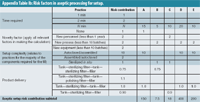
Appendix Table Ib: Risk factors in aseptic processing for setup.
Facility B. A heavily automated facility of late-1980s construction dedicated to the production of a single freeze-dried product in multiple containers and strengths.
- weighted interventions/h is 5;
- fill speed is 300 vials/min;
- process duration is 5 h;
- I R is 0.00027 interventions/container.
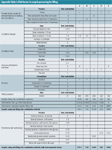
Appendix Table Ic: Risk factors in aseptic processing for filling.
Facility C. An early-generation isolator-based facility intended for various products and formulations.
- Weighted interventions/h is 60;
- Fill speed is 80 vials/min;
- Process duration is 4 h;
- I R is 0.0125 interventions/container.
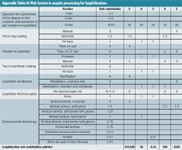
Appendix Table Id: Risk factors in aseptic processing for lyophilization.
Facility D. A small-volume suite for the production of clinical materials.
- Weighted interventions/h is 60;
- Fill speed is 30 vials/min;
- Process duration is 2 h;
- I R is 0.033 interventions/container.

Appendix Table Ie: Risk factors in aseptic processing (cumulative).
Facility E. A low-volume clinical suite relying on manual filling.
- Process duration is 4 h;
- I R is 4 interventions/container.

Appendix Table If: Risk factors in aseptic processing (from original AkersâAgalloco method) (7).
These values differ from those determined in the initial version of the risk analysis method (see Table If). The risk levels associated with Facilities A and E have been reversed: Facility E now has a lower risk than Facility A. This reversal is largely because of a substantial increase in the risk level associated with Facility A primarily from a change in the multiplier for thermocouple placement on each shelf. Given the extent of the changes made in the model, this difference is unremarkable. The salient objective of the method: the ability to discriminate among common facility designs and operating practices for aseptic processing risk assessment remains intact despite the changes.

Drug Solutions Podcast: A Closer Look at mRNA in Oncology and Vaccines
April 30th 2024In this episode fo the Drug Solutions Podcast, etherna’s vice-president of Technology and Innovation, Stefaan De Koker, discusses the merits and challenges of using mRNA as the foundation for therapeutics in oncology as well as for vaccines.